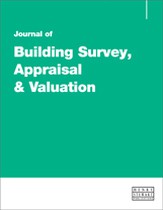Heritage at risk — benefits of collaborative working : A case study of Necarne Castle, Irvinestown, Co. Fermanagh
Abstract
The heritage sector, and more specifically the growing list of buildings at risk across the UK, presents wide-ranging changes to owners, heritage bodies, potential funders, consultants and specialist advisers and contractors. When protected buildings and heritage assets reach an advanced state of decay the challenges escalate, and as solutions are sought the problems also escalate, with costs spiralling. Remedial works’ costs and budgets are often difficult to quantify, which in turn creates challenges for both funding and procurement, where cost certainty and low risk is desired. The solution requires clear thinking and objectives that are achievable. In many cases ‘grand aspirations’ fail to get off the ground, becoming too wide-ranging in their aims. With heritage at risk, the extent of unknown works is often extensive and difficult to fully quantify until works are in progress. This never sits comfortably with funders and can be the vicious circle of unknown work, unknown cost, that prevents projects starting. Effective experienced project teams are not engaged sufficiently early to contribute to the strategies. The need for realistic practical options that can be implemented efficiently and promptly requires collaboration from a wide range of sources. Bringing together clients, funders, consultants, contractors and statutory heritage bodies in a spirit of collaboration and common objectives is at the heart of a successful project; this enables works and cost control to be effectively managed, and most importantly allows works to start and the cycle of decay and decline to be halted. This case study shows how a committed local council secured funding and assembled a team of advisers, consultants and contractors to bring a significant heritage-at-risk asset back from the brink of collapse, demonstrating how trust in collaborative working exceeded all expectations and delivered additional stabilisation works within the available funding.
The full article is available to subscribers to the journal.
Author's Biography
Jon Avent BSc (Hons) CEng MIStructE, IHBC, CARE Conservation Accredited Engineer is a director of Mann Williams Consulting Civil and Structural Engineers. He has worked on a wide range of projects across the UK, including many Grade 1 properties and scheduled monuments, for clients including the National Trust, Historic England, Cadw in Wales, DfC-HED in Ireland, many local authorities and private clients. Jon was one of the first engineers to achieve accreditation under the Institution of Civil and Structural Engineers (CARE) scheme recognising competence and experience in the field of building conservation and is a former Chair of the CARE Panel. He provides specialist conservation engineering advice on the National Trust’s Specialist Advisory Panel.
Citation
Avent, Jon (2022, September 1). Heritage at risk — benefits of collaborative working : A case study of Necarne Castle, Irvinestown, Co. Fermanagh. In the Journal of Building Survey, Appraisal & Valuation, Volume 11, Issue 2. https://doi.org/10.69554/ZUGD3921.Publications LLP
